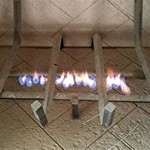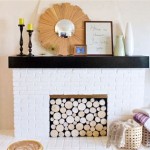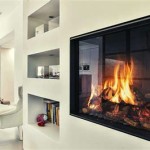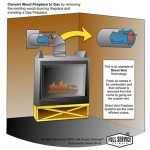Fireplace Mantel With Storage Plans: Combining Aesthetics and Functionality
The fireplace mantel has long served as a focal point in living spaces, offering a place for decorative items and adding architectural interest. However, a traditional mantel often neglects the possibility of incorporating storage, a valuable asset particularly in smaller homes or rooms where maximizing space is crucial. Fireplace mantel with storage plans address this need by integrating shelving, cabinets, or drawers directly into the mantel design. The result is a functional and visually appealing feature that enhances both the aesthetics and organizational capabilities of the living area.
These plans range in complexity from simple shelves added beneath the mantel surface to elaborate designs incorporating entire wall units that surround the fireplace. The choice of design depends largely on the available space, the desired storage capacity, and the overall style of the room. Understanding the considerations involved in designing and constructing a fireplace mantel with storage is essential for achieving a successful and long-lasting result.
Key Considerations in Design and Planning
Before embarking on a fireplace mantel with storage project, careful consideration must be given to several key factors. These considerations will influence the design choices, material selection, and construction methods. Overlooking these aspects can lead to a final product that is either aesthetically unappealing or structurally unsound.
Firstly, the fireplace type and its clearances are paramount. Gas fireplaces, wood-burning fireplaces, and electric fireplaces all have different requirements for clearances from combustible materials. These clearances are typically specified by the manufacturer and are also often regulated by local building codes. Failure to adhere to these clearances can create a significant fire hazard. The design must incorporate these clearances, ensuring that the mantel and any surrounding storage components maintain the required distance from the firebox or chimney. Heat shields may be necessary to protect wooden structures from excessive heat exposure.
Secondly, the existing architecture and style of the room play a significant role in the design choices. The mantel should complement the existing architectural details, such as crown molding, baseboards, and window trim. A modern, minimalist mantel might look out of place in a traditionally styled home, while an ornate, heavily detailed mantel might clash with a contemporary aesthetic. Consider the overall color palette of the room and select materials and finishes that harmonize with the existing decor. The goal is to create a cohesive and integrated design that enhances the overall visual appeal of the space.
Thirdly, the intended use of the storage spaces is a crucial factor in determining the design and layout. If the storage is intended for books, open shelving might be appropriate. If the storage is intended for concealing media equipment or storing less visually appealing items, closed cabinets or drawers might be a better choice. The size and configuration of the storage compartments should be tailored to the specific items that will be stored. Consider the ease of access to the storage areas and ensure that the design allows for comfortable and convenient retrieval of items.
Finally, structural integrity is a critical consideration. The mantel and storage components must be strong enough to support their own weight, as well as the weight of any items stored within them. The design should incorporate appropriate structural elements, such as sturdy framing, solid shelves, and robust hardware. If the mantel is to be mounted on a brick or stone fireplace, appropriate anchoring methods must be used to ensure a secure and stable connection. Consult with a structural engineer if there are any doubts about the structural integrity of the design.
Material Selection and Construction Techniques
The choice of materials for a fireplace mantel with storage project is a critical decision that will impact both the aesthetics and the durability of the finished product. Common materials include wood, MDF (medium-density fiberboard), and occasionally, stone or metal accents. Each material has its own advantages and disadvantages, and the selection should be based on factors such as cost, appearance, and ease of workability.
Solid wood is a popular choice for mantels due to its natural beauty, durability, and workability. Hardwoods such as oak, maple, and cherry are often preferred for their strength and resistance to wear and tear. Softwoods such as pine and fir are more affordable but may require more care to prevent dents and scratches. Solid wood mantels can be stained, painted, or left natural to showcase the wood grain. However, solid wood is also prone to expansion and contraction with changes in humidity, which can lead to cracking or warping if not properly seasoned and sealed.
MDF is a cost-effective alternative to solid wood that offers a smooth, uniform surface ideal for painting. MDF is less susceptible to expansion and contraction than solid wood, making it a good choice for painted mantels in areas with fluctuating humidity levels. However, MDF is not as strong as solid wood and is more susceptible to damage from moisture. It is important to use a primer and several coats of paint to protect MDF from moisture absorption. MDF is also heavier than solid wood, which may require additional support during installation.
Construction techniques for a fireplace mantel with storage will vary depending on the design and materials used. A basic mantel shelf can be constructed using simple joinery techniques, such as butt joints, screws, and glue. More complex designs may require advanced joinery techniques, such as mortise and tenon joints or dovetail joints. It is important to use high-quality hardware and fasteners to ensure a strong and durable connection.
When building cabinets or drawers for the storage components, precise measurements and accurate cuts are essential. Use a table saw or circular saw with a guide to ensure straight and accurate cuts. Assemble the cabinets and drawers using screws and glue, and reinforce the corners with corner braces or wood blocks. Use high-quality drawer slides and hinges for smooth and reliable operation. Pay attention to the alignment of the doors and drawers to ensure a professional-looking finish.
Installing the mantel and storage components requires careful planning and execution. Ensure that the mounting surface is level and plumb. Use shims to level the mantel if necessary. Secure the mantel to the wall using appropriate fasteners, such as lag bolts or masonry anchors. Conceal the fasteners with wood filler or decorative plugs. Apply a sealant or caulk around the edges of the mantel to prevent moisture from entering the wall cavity.
Integrating Functionality and Aesthetics
The true success of a fireplace mantel with storage project lies in its ability to seamlessly integrate functionality with aesthetics. The storage components should not only provide practical storage solutions but also enhance the overall visual appeal of the fireplace and the room.
Consider incorporating design elements that visually break up the storage areas and prevent them from appearing too bulky or monotonous. This can be achieved through the use of different door styles, such as shaker doors, raised panel doors, or glass-front doors. Vary the depth of the shelves or cabinets to create visual interest. Add decorative hardware, such as knobs, pulls, or handles, to enhance the overall aesthetic.
Lighting can also play a key role in enhancing the functionality and aesthetics of the mantel and storage areas. Install recessed lighting above the mantel to highlight decorative items or artwork. Add task lighting to the shelves or cabinets to improve visibility and ease of use. Consider using dimmable lighting to create a warm and inviting ambiance.
The arrangement of items on the mantel and shelves is also crucial for creating a visually appealing display. Follow the principles of design, such as balance, proportion, and rhythm, to create a harmonious and balanced composition. Group items of similar color, texture, or shape together. Leave some empty space to allow the eye to rest and prevent the display from appearing cluttered. Incorporate personal items, such as photographs, artwork, and souvenirs, to add a personal touch and create a sense of warmth and comfort.
Finally, regularly declutter and reorganize the storage areas to maintain a clean and organized appearance. Remove any items that are no longer needed or used. Rotate the items on display to keep the mantel and shelves looking fresh and interesting. A well-organized and visually appealing fireplace mantel with storage can significantly enhance the overall ambiance and functionality of the living space.

Wood Mantle With Storage Ana White

Diy Fireplace Mantel With Storage Designed Simple

Diy Fireplace Mantel With Storage Designed Simple

Diy Fireplace Mantel With Storage Designed Simple

Diy Fireplace Mantel Designatedspacedesign Com

20 Sneaky Storage Ideas Home Fireplace Built Ins

How To Build A Diy Fireplace With Electric Insert Storage Shiplap Modern Farmhouse

Diy Fireplace Mantel With Storage Designed Simple

30 Tips To Diy And Decorate Your Fireplace Mantel Shelf

How To Diy An Amazing Electric Fireplace Surround And Mantle Drawer
Related Posts








